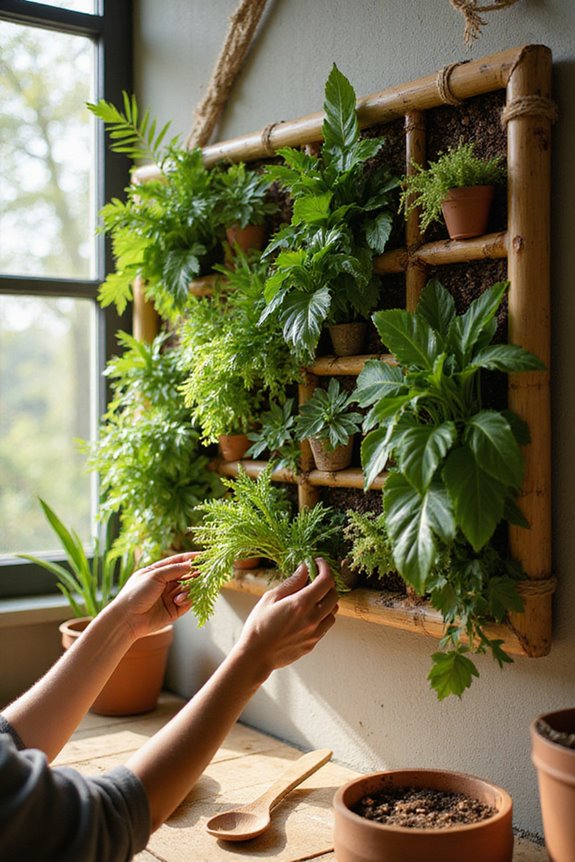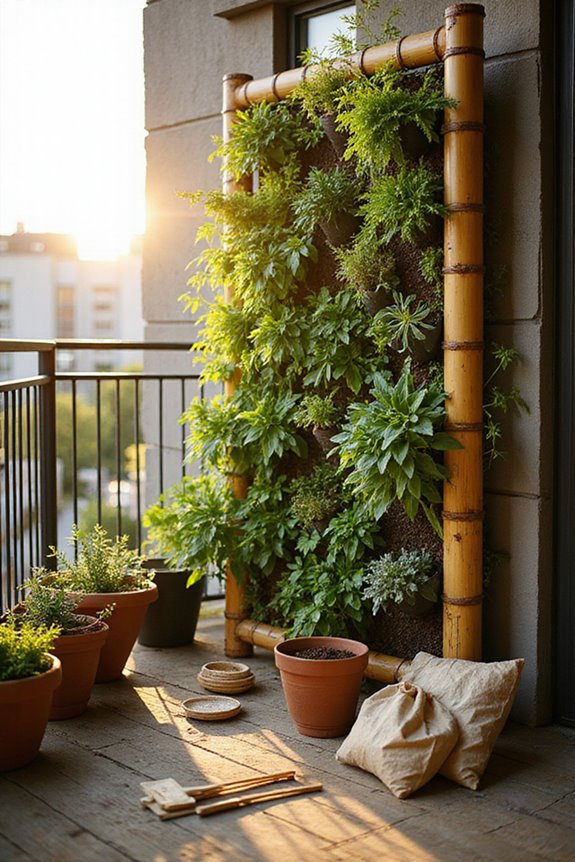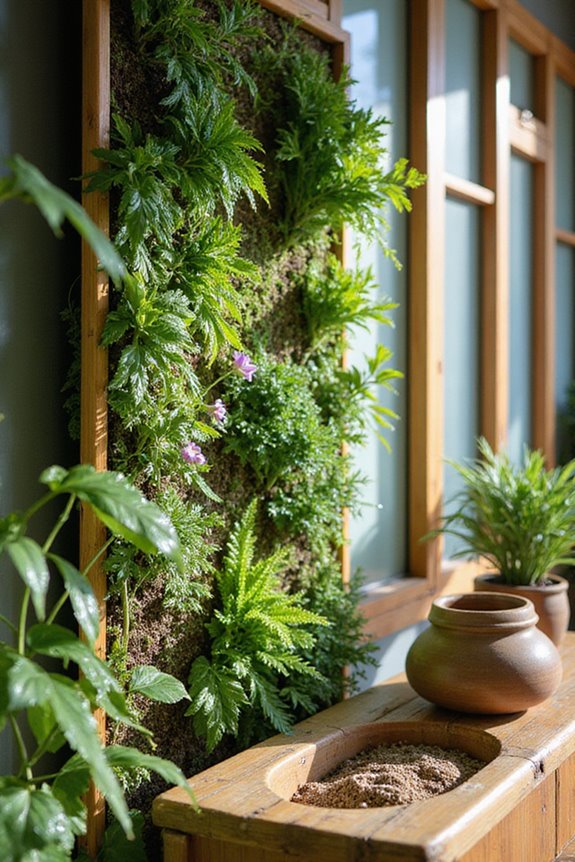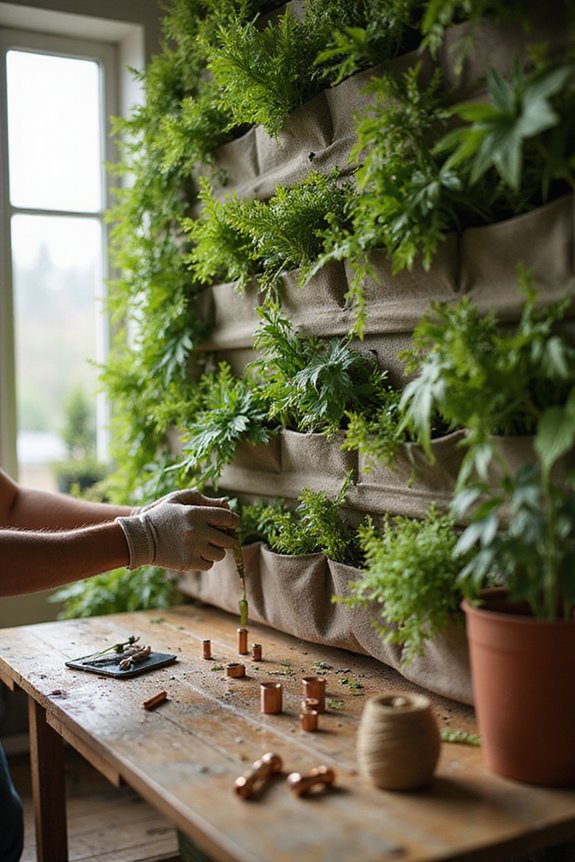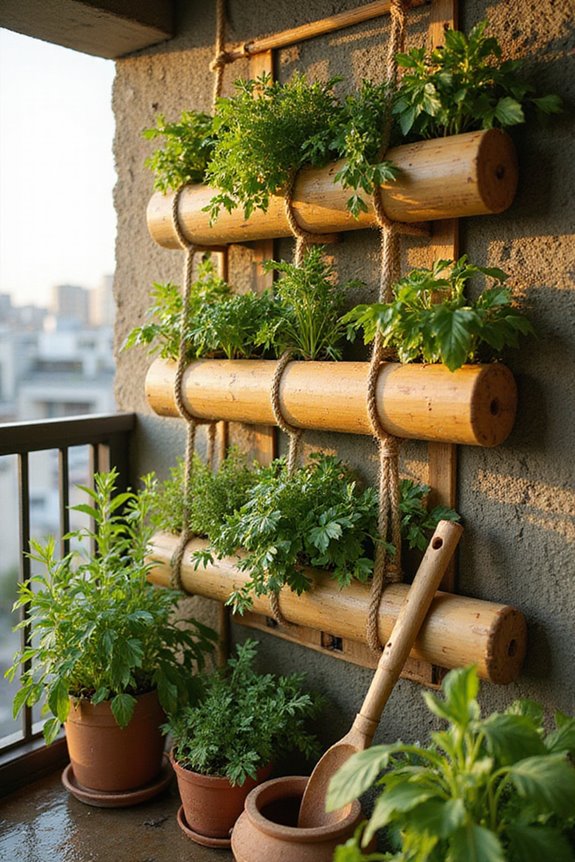To install living wall structures, we should start with a thorough site assessment and planning. Next, we’ll mount a sturdy framework using pressure-treated lumber. After that, we can install modular planters filled with good-quality potting mix. It’s important to set up a drip irrigation system for efficient watering. Finally, we’ll attach plants, ensuring proper spacing for growth. This process is vital for creating a vibrant vertical garden that thrives over time. More tips are included ahead.
Key Takeaways
- Conduct a site assessment to determine wall suitability, dimensions, and proximity to water sources for optimal planting conditions.
- Assemble a sturdy structural framework using pressure-treated lumber, ensuring consistent rail spacing and secure attachment for drainage and airflow.
- Choose and arrange modular tanks or planters with quality potting mix, prioritizing plants suited for vertical growth and easy maintenance access.
- Set up an efficient drip irrigation system, including a backflow preventer and pressure regulation, to ensure effective water distribution to plants.
- Establish a maintenance routine including irrigation testing, pruning every three months, and keeping a log for watering and fertilization schedules.
Preparation and Planning
Before we plunge into the installation of living wall structures, proper preparation and planning are essential. A thorough site assessment is our first step. We need to identify a wall that receives enough light for our chosen plants. Measuring the dimensions will help us calculate the materials required. We should also check the wall’s condition and proximity to a water source.
Next, plant selection is vital. We want to choose plants suited for our environment and light levels. It’s smart to pick species with similar water and nutrient needs, making care simpler. Including a mix of ground covers, climbers, and flowering plants adds diversity. By following these steps, we’re setting ourselves up for a successful living wall installation.
Mounting the Structural Framework
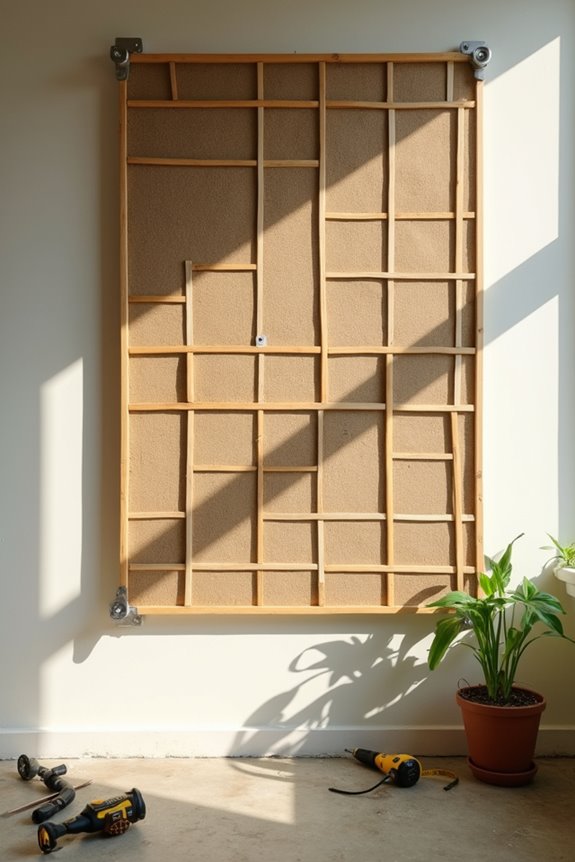
Once we have our materials ready, it’s time to focus on mounting the structural framework of our living wall. First, we’ll assemble our framework materials, using pressure-treated lumber and galvanized metal for durability. The rails should be set at consistent spacing of at least 12 inches apart, allowing ample room for our plants.
Next, we’ll secure the uprights across the rails with pilot holes drilled for easy assembly. Remember, the center intersection should remain clear for structural screws.
When it’s time to mount, we’ll drive screws through the pilot holes into PVC standoffs, ensuring proper drainage and airflow. Finally, let’s check that everything is level before we tighten up our framework and remove any temporary braces.
Installing Modular Tanks or Planters
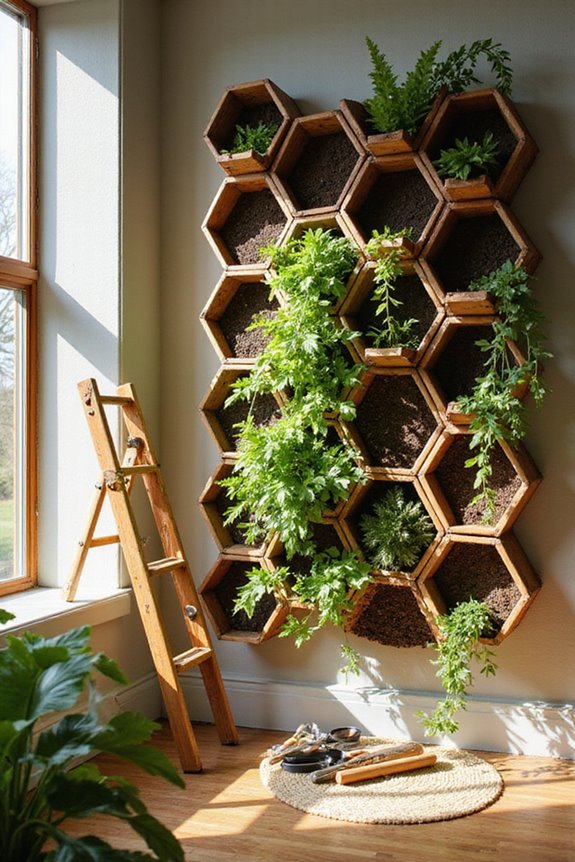
Installing modular tanks or planters can greatly enhance the aesthetics and functionality of our living wall. First, we need to take into account the design considerations, guaranteeing that the tanks or planters fit the wall’s weight limits and attachment types. Next, we should select plants that thrive in vertical spaces, focusing on healthy specimens that are pest-free.
When preparing the tanks or planters, we’ll fill them with high-quality potting mix and guarantee proper drainage features to prevent root rot. Accessibility is key, so we’ll arrange the modules for easy planting and maintenance. Finally, let’s make certain the spacing allows for growth and airflow, grouping plants with similar needs to create a harmonious arrangement.
Setting up Irrigation System
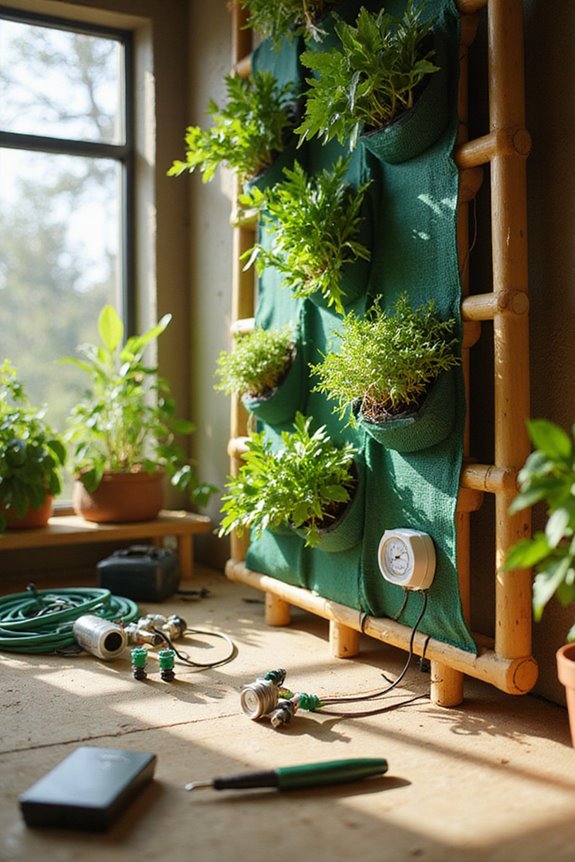
Setting up an irrigation system is essential for maintaining the health of our living wall. We should consider a drip irrigation approach to guarantee efficient water distribution. First, we must install a backflow preventer to keep the water safe. Next, we need to set up pressure regulation, aiming for 15 PSI upstream of each valve. This helps us avoid damage and guarantees uniform watering.
Here’s a quick checklist:
- Use UV-resistant pipe and fittings.
- Install a micron filter to prevent clogging.
- Guarantee each valve has 8-10 gallons per minute.
- Consider a digital timer for automated control.
Attaching Planting Medium and Plants
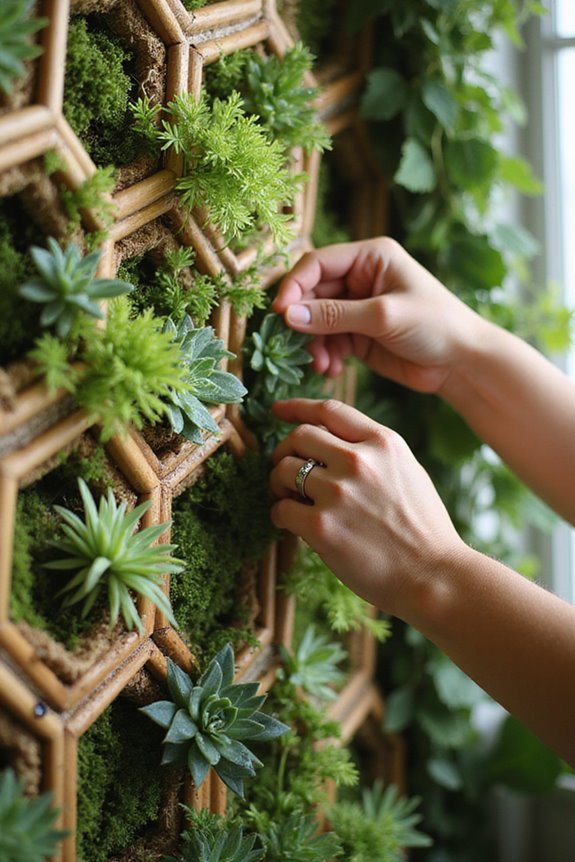
Attaching the planting medium and plants to our living wall is an essential step in creating a thriving vertical garden. First, we’ll select a well-draining planting medium that suits our chosen plants. We can use a mix of potting soil and specialized media for aeration and moisture retention.
Next, we’ll securely place the medium in pockets or planter boxes. When positioning our plants, we want the roots facing forward to encourage healthy growth. It’s important to make holes that fit the roots without bending them. After planting, we gently firm the soil around the roots to eliminate air pockets.
Finally, we should water the plants right away to help them settle into their new home.
Finalizing Installation and Maintenance Setup
After we’ve successfully attached our planting medium and plants, the next step is to finalize the installation and set up a maintenance plan. First, we should conduct irrigation testing to verify our system is leak-free and functioning well. Adjust the irrigation schedule according to seasonal changes and plant needs to maintain consistent moisture without overwatering.
Next, we need to establish a pruning schedule, ideally every three months, to remove wilted leaves and prevent overcrowding. This helps our plants thrive and maximizes light exposure. Additionally, using self-watering systems can significantly reduce daily maintenance efforts and ensure even moisture distribution. Finally, let’s keep a detailed maintenance log, noting watering, fertilization, and any pest control measures. This documentation will guide our future efforts and help us maintain a healthy, vibrant living wall.
Frequently Asked Questions
What Types of Plants Are Best for Living Walls?
When we think about plant selection for our vertical gardening projects, we envision vibrant ferns, cascading pothos, and delicate flowers. Together, let’s create living walls that breathe life and color into our shared spaces.
How Much Sunlight Do Living Wall Plants Need?
When we think about sunlight requirements, living wall plants generally need 10-14 hours of light daily. Careful plant placement guarantees they thrive, avoiding harsh direct sun, which can damage their beautiful foliage.
Can I Install a Living Wall Indoors?
Absolutely, we can install a living wall indoors! With proper lighting and wall maintenance, indoor gardening becomes a vibrant, shared journey, bringing nature into our spaces and creating a welcoming environment for everyone.
How Do I Prevent Pests in a Living Wall?
Think of our living wall as a vibrant community; to keep it thriving, we must embrace organic solutions for pest control. Together, we can maintain a healthy environment, ensuring our plants flourish and pests stay away.
What Is the Cost of Installing a Living Wall?
When considering installation costs for a living wall, we should expect to spend anywhere from £500 to £1,500 per square metre. Factors like design complexity and materials can impact our final costs considerably.

